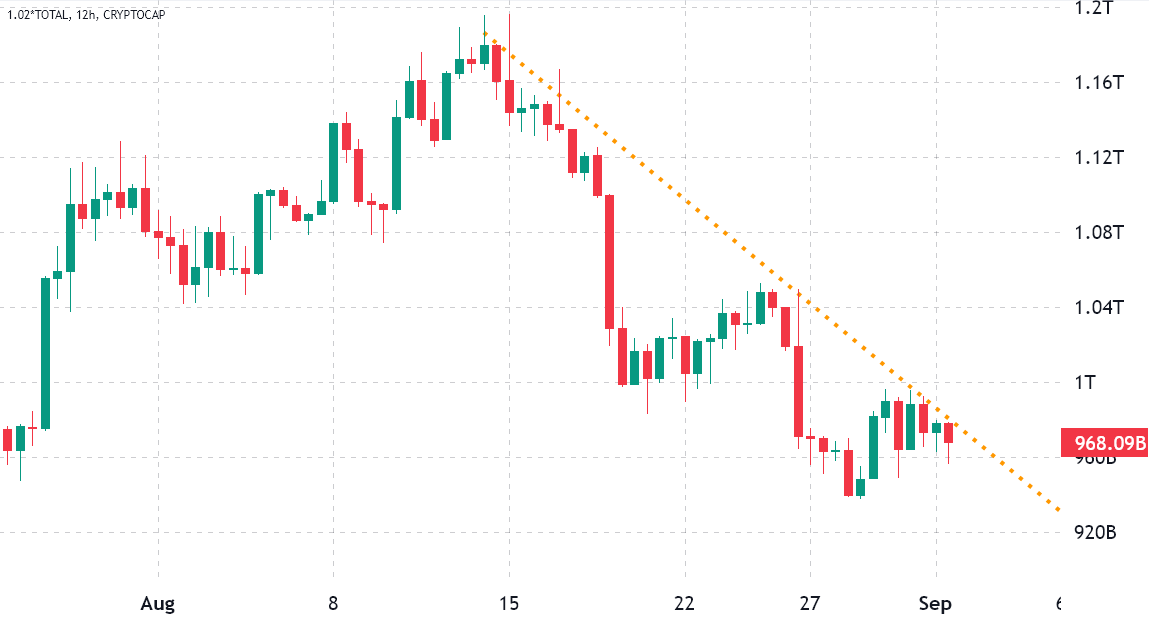The total crypto market capitalization continues to crumble as the dollar index hits a 20-year high
From a bearish perspective, there is a reasonable probability that the crypto market entered a descending channel (or wedge) on August 15th after it failed to break above the total resistance of the $1.2 trillion market cap. Although the pattern is not yet clear, the last couple of weeks have not been positive.

For example, the total market capitalization of $940 billion on August 29 was the lowest in 43 days. The worsening conditions have been accompanied by a steep correction in traditional markets, with the tech-heavy Nasdaq Composite Index down 12% since August 15 and even WTI oil prices falling 11% from August 29 to September 1.
Investors sought refuge in the dollar and US Treasuries after Federal Reserve Chairman Jerome Powell reiterated the bank’s commitment to contain inflation by tightening the economy. As a result, investors took profits in riskier assets, leading the US Dollar Index (DXY) to reach its highest level in over two decades at 109.6 on September 1. The index measures the dollar’s strength against a basket of top foreign currencies.
More importantly, the regulatory news flow remains largely unfavorable, especially after US federal prosecutors requested internal records from the Binance crypto exchange to look deeper into possible money laundering and recruitment of US clients. Since late 2020, authorities have been investigating whether Binance violated the Bank Secrecy Act, according to Reuters.
Crypto investor sentiment is moving back into the bearish zone
The risk-off attitude caused by Federal Reserve tightening led investors to expect a broader market correction and is negatively impacting growth stocks, commodities and cryptocurrencies.

The data-driven sentiment Fear and Greed Index peaked on August 14 when the indicator reached a neutral 47/100 reading, which didn’t sound very promising either. On September 1, the metric reached 20/100, the lowest reading of 46, and is usually considered a bearish level.
Below are the winners and losers from the past seven days as total crypto capitalization fell 6.9% to $970 billion. While Bitcoin (BTC) and Ether (ETH) showed declines of 7% to 8%, a handful of mid-cap altcoins fell 13% or more during the period.

eCash (XEC) jumped 16.5% after lead developer Amaury Séchet announced the Avalanche post-consensus launch on the eCash mainnet, expected on September 14. The update aims to bring 1-block finality and increase protection against 51% attacks.
NEXO gained 3.4% after committing an additional $50 million to the buyback program, giving the company more discretion to buy back its original token on the open market.
Helium (HNT) lost 29.3% after core developers suggested dropped its own blockchain in favor of Solana’s. If passed, helium-based HNT, IOT and MOBILE tokens and data credits (DCs) will also be transferred to the Solana blockchain.
Avalanche (AVAX) fell 18.2% after CryptoLeaks released an unverified video showing Kyle Roche, the partner at Roche Freedman, saying he might sue Solana, one of Avalanche’s top rivals, on behalf of Ava Labs.
Most tokens performed negatively, but retail demand in China improved slightly
The OKX Tether (USDT) premium is a good measure of China-based crypto trader demand. It measures the difference between China-based peer-to-peer (P2P) trades and the US dollar.
Excessive buying demand tends to push the indicator above fair value of 100%, and during bearish markets, Tether’s market supply is flooded causing a discount of 4% or higher.

On October 30, the Tether price in Asia-based peer-to-peer markets reached a premium of 0.4%, the highest level since mid-June. Curiously, the move occurred while the overall crypto market cap fell 18.5% since August 15th. Data shows that there has been no panic selling by retailers, as the index remains relatively neutral.
Traders must also analyze futures markets to rule out externalities specific to the Tether instrument. Perpetual contracts, also known as inverse swaps, have a built-in rate that is usually charged every eight hours. Exchanges use this fee to avoid imbalances in currency risk.
A positive funding rate indicates that longs (buyers) require more leverage. However, the opposite situation occurs when shorts (sellers) require additional leverage, causing the funding rate to become negative.

Perpetual contracts reflected moderate bearish sentiment as the accumulated funding rate was negative in all cases. The current fees were the result of a volatile situation with higher demand from leveraged shorts and those betting on a price decline. Still, even the negative weekly funding rate of 0.70% for Ethereum Classic (ETC) was not enough to dissuade short sellers.
Negative regulatory and macroeconomic pin down sentiment
The negative weekly performance of 6.9% should be the least of investors’ worries right now as regulators have targeted major crypto exchanges. For example, they claim that altcoins should have been registered as securities and that the sector has been used to facilitate money laundering.
Moreover, the weak sentiment measures and unbalanced leverage data signal that investors are worried about the effects of a global recession. While Tether data in Asian markets shows no signs of retail panic selling, there is no evidence that traders have a bullish appetite as the overall crypto market capitalization neared a 45-day low. Thus, bears have reason to believe that the current descending formation will continue in the coming weeks.
The views and opinions expressed herein are solely those of author and do not necessarily reflect the views of Cointelegraph. Every investment and trade involves risk. You should do your own research when making a decision.


